Applying Biodiversity Metrics as Surrogates to a Habitat Conservation Plan
Abstract
:1. Introduction
| Type | Metric | Description |
|---|---|---|
| Taxa Richness | Total Terrestrial Vertebrate Richness (A, C) | Total terrestrial vertebrate species (amphibians, birds, mammals, reptiles; n = 1590) as measured by modeled habitat present within a pixel in the conterminous U.S. |
| Total Mammal Richness (A) | All mammals (n = 365) as measured by modeled habitat present within a pixel in the conterminous U.S. | |
| Total Reptile Richness (A) | All reptiles (n = 322) as measured by modeled habitat present within a pixel in the conterminous U.S. | |
| Total Amphibian Richness (A) | All amphibians (n = 282) as measured by modeled habitat present within a pixel in the conterminous U.S. | |
| Total Bird Richness (A, C) | All birds (n = 621) as measured by modeled habitat present within a pixel in the conterminous U.S. | |
| Winter Bird Richness (A, C) | All bird (n = 621) as measured by modeled winter habitat present within a pixel in the conterminous U.S. | |
| Summer Bird Richness (A, C) | All birds (n = 621) as measured by modeled summer habitat present within a pixel in the conterminous U.S. | |
| Harvestable | Total Harvestable Species Richness (B, C) | All Species (n = 186) regulated by State Wildlife Agencies as measured by modeled habitat present within a pixel in the conterminous U.S. |
| Total Big Game Species Richness (B, C) | Big Game Species (n = 18) regulated by State Wildlife Agencies as measured by modeled habitat present within a pixel in the conterminous U.S. | |
| Total Small Game Species Richness (B, C) | Small Game (n = 121) and Upland Game Species regulated by State Wildlife Agencies as measured by modeled habitat present within a pixel in the conterminous U.S. | |
| Furbearer Species Richness (B, C) | Furbearing Species (n = 37) regulated by State Wildlife Agencies as measured by modeled habitat present within a pixel in the conterminous U.S. | |
| Waterfowl Species Richness (B, C) | Waterfowl Species (n = 48) regulated by Federal/State Wildlife Agencies as measured by modeled habitat present within a pixel in the conterminous U.S. | |
| Rare Species | Rarity Index; Total Terrestrial Vertebrates (A) | Number of terrestrial species (n = 399) with the lowest quartile of modeled habitat area within the conterminous U.S. |
| Rarity Index; Total Mammals (A) | Number of mammal species (n = 92) with the lowest quartile of modeled habitat area within the conterminous U.S. | |
| Rarity Index; Total Reptiles (A) | Number of reptile species (n = 82) with the lowest quartile of modeled habitat area within the conterminous U.S. | |
| Rarity Index; Total Amphibians (A) | Number of amphibian species (n = 72) with the lowest quartile of modeled habitat area within the conterminous U.S. | |
| Rarity Index; Total Birds (A) | Number of bird species (n = 156) with the lowest quartile of modeled habitat area within the conterminous U.S. | |
| Conservation Lists | T & E Terrestrial Vertebrate Richness (A, C) | Species (n = 52) listed as Federally Threatened or Endangered under the Endangered Species Act (7) as measured by modeled habitat present within a pixel in the conterminous U.S. |
| Global Rank Species Richness; G1, G2, and G3 (A) | Species listed G1, G2, G3 by NatureServe (n = 244) as measured by modeled habitat present within a pixel in the conterminous U.S. G1-critically imperiled; G2–imperiled; G3-vulnerable | |
| IUCN Threatened Terrestrial Vertebrate Species Richness (A) | Species listed as Endangered (n = 40) by the IUCN (International Union for Conservation of Nature) as measured by modeled habitat present within a pixel in the conterminous U.S. | |
| Audubon Climate-endangered Bird Species Richness (A) | Species listed as Climate-Endangered (n = 122) as referenced by Audubon and measured by modeled habitat present within a pixel in the conterminous U.S. | |
| Audubon Climate-threatened Bird Species Richness (A) | Species listed as Climate-Threatened (n = 182) as referenced by Audubon and measured by modeled habitat present within a pixel in the conterminous U.S. | |
| Partners in Flight Watch List Species Richness (A, C) | Species listed by Partners in Flight Watch List (n = 80) as measured by modeled habitat present within a pixel in the conterminous U.S. | |
| Birds of Conservation Concern Species Richness; State of the Birds 2016 (A, C) | Species listed as Conservation Concern in State of the Birds 2016 (n = 117) as measured by modeled habitat present within a pixel in the conterminous U.S. | |
| Common Birds in Steep Decline (A, C) | Species listed by Partners in Flight as common bird species in deep decline (n = 25) as measured by modeled habitat present within a pixel in the conterminous U.S. | |
| Partners in Amphibian and Reptile Conservation (PARC) Species Richness (A) | Species listed as either T&E, G1-G3 or IUCN (n = 167) as measured by modeled habitat present within a pixel in the conterminous U.S. |
2. Materials and Methods
2.1. Study Area
2.2. Landscape-Level Linkages
2.3. Covered Species
2.4. Biodiversity Metrics
2.5. Desert Tortoise and Desert Kit Fox
2.6. Analysis
3. Results
3.1. Apple Valley in Context
3.2. Desert Tortoise and Desert Kit Fox
4. Discussion
5. Conclusions
Author Contributions
Funding
Institutional Review Board Statement
Data Availability Statement
Acknowledgments
Conflicts of Interest
References
- McDonald, R.I.; Marcotullio, P.J.; Güneralp, B. Urbanization and global trends in biodiversity and ecosystem services. In Urbanization, Biodiversity and Ecosystem Services: Challenges and Opportunities; Springer: Dordrecht, The Netherlands, 2013; pp. 31–52. [Google Scholar]
- Soulé, M.E. What Is Conservation Biology? BioScience 1985, 35, 727–734. [Google Scholar]
- National Research Council. Perspectives on Biodiversity: Valuing Its Role in an Everchanging World; National Academies Press: Cambridge, MA, USA, 1999; ISBN 0-309-06581-X.
- Rodgers, K.; Willcox, A.; Willcox, E. Common Influences on the Success of Habitat Conservation Planning under the Endangered Species Act. Hum. Dimens. Wildl. 2017, 22, 438–453. [Google Scholar] [CrossRef]
- Harris, J.B.C.; Reid, J.L.; Scheffers, B.R.; Wanger, T.C.; Sodhi, N.S.; Fordham, D.A.; Brook, B.W. Conserving Imperiled Species: A Comparison of the IUCN Red List and US Endangered Species Act. Conserv. Lett. 2012, 5, 64–72. [Google Scholar] [CrossRef]
- Kareiva, P.; Marvier, M. What Is Conservation Science? BioScience 2012, 62, 962–969. [Google Scholar] [CrossRef]
- Endangered Species Act. 16 United States Code, §§1534–1544. 1973.
- Underwood, J.G. Combining Landscape-Level Conservation Planning and Biodiversity Offset Programs: A Case Study. Environ. Manag. 2011, 47, 121–129. [Google Scholar] [CrossRef]
- US Fish and Wildlife Service. Habitat Conservation Planning and Incidental Take Permit Processing Handbook; USFWS and National Marine Fisheries Service: Washington, DC, USA, 1996.
- US Fish and Wildlife Service and National Marine Fisheries Service (NMFS). Habitat Conservation Planning and Incidental Take Permit Processing Handbook; US Fish and Wildlife Service and National Marine Fisheries Service: Washington, DC, USA, 2016.
- Rahn, M.E.; Doremus, H.; Diffendorfer, J. Species Coverage in Multispecies Habitat Conservation Plans: Where’s the Science? BioScience 2006, 56, 613–619. [Google Scholar] [CrossRef] [Green Version]
- Millennium Ecosystem Assessment (Program) (Ed.) Ecosystems and Human Well-Being: Synthesis; Island Press: Washington, DC, USA, 2005; ISBN 978-1-59726-040-4. [Google Scholar]
- Boykin, K.G.; Kepner, W.G.; Bradford, D.F.; Guy, R.K.; Kopp, D.A.; Leimer, A.K.; Samson, E.A.; East, N.F.; Neale, A.C.; Gergely, K.J. A National Approach for Mapping and Quantifying Habitat-Based Biodiversity Metrics across Multiple Spatial Scales. Ecol. Indic. 2013, 33, 139–147. [Google Scholar] [CrossRef]
- Secretariat, C.B.D. Strategic Plan for Biodiversity 2011–2020, Including Aichi Biodiversity Targets. In Proceedings of the Secretariat of the Convention on Biological Diversity, Nagoya, Japan, 29 October 2010. [Google Scholar]
- Secretariat, C.B.D. Convention on Biological Diversity. In Proceedings of the Convention on Biological Diversity, Rio de Janeiro, Brazil, 5–14 June 1992. [Google Scholar]
- Lindenmayer, D.B.; Likens, G.E. Direct Measurement Versus Surrogate Indicator Species for Evaluating Environmental Change and Biodiversity Loss. Ecosystems 2011, 14, 47–59. [Google Scholar] [CrossRef]
- Samson, E.; Boykin, K.; Kepner, W.; Andersen, M.; Fernald, A. Evaluating Biodiversity Metric Response to Forecasted Land Use Change in the Northern Rio Grande Basin. Environments 2018, 5, 91. [Google Scholar] [CrossRef] [Green Version]
- Gergely, K.J.; Boykin, K.G.; McKerrow, A.J.; Rubino, M.J.; Tarr, N.M.; Williams, S.G. Gap Analysis Project (GAP) Terrestrial Vertebrate Species Richness Maps for the Conterminous U.S.; U.S. Geological Survey: Reston, VA, USA, 2019; p. 99.
- Pilliod, D.S.; Jeffries, M.I.; Arkle, R.S.; Olson, D.H. Reptiles under the Conservation Umbrella of the Greater Sage-grouse. J. Wildl. Manag. 2020, 84, 478–491. [Google Scholar] [CrossRef]
- Caro, T.M.; O’Doherty, G. On the Use of Surrogate Species in Conservation Biology. Conserv. Biol. 1999, 13, 805–814. [Google Scholar] [CrossRef]
- Ozaki, K.; Isono, M.; Kawahara, T.; Iida, S.; Kudo, T.; Fukuyama, K. A Mechanistic Approach to Evaluation of Umbrella Species as Conservation Surrogates. Conserv. Biol. 2006, 20, 1507–1515. [Google Scholar] [CrossRef] [PubMed]
- Southwick Associates. The Conservation Economy in America: Direct Investments and Economic Contributions; Prepared for: The National Fish and Wildlife Foundation; Southwick Associates: Fernandina Beach, FL, USA, 2013; p. 26. [Google Scholar]
- Hohensee, P.; Samuel, M.; Drake, D. For What It’s Worth: Appreciating the Economic Value of Wildlife. Wildl. Prof. 2017, 11, 40–43. [Google Scholar]
- Pickard, B.R.; Daniel, J.; Mehaffey, M.; Jackson, L.E.; Neale, A. EnviroAtlas: A New Geospatial Tool to Foster Ecosystem Services Science and Resource Management. Ecosyst. Serv. 2015, 14, 45–55. [Google Scholar] [CrossRef] [Green Version]
- Seaber, P.R.; Kapinos, F.P.; Knapp, G.L. Hydrologic Unit Maps: US Geological Survey Water Supply Paper 2294; US Geological Survey: Denver, CO, USA, 1987.
- Scott, J.M.; Davis, F.; Csuti, B.; Noss, R.; Butterfield, B.; Groves, C.; Anderson, H.; Caicco, S.; D’Erchia, F.; Edwards, T.C., Jr. Gap Analysis: A Geographic Approach to Protection of Biological Diversity. Wildl. Monogr. 1993, 123, 3–41. [Google Scholar]
- Aycrigg, J.L.; Davidson, A.; Svancara, L.K.; Gergely, K.J.; McKerrow, A.; Scott, J.M. Representation of Ecological Systems within the Protected Areas Network of the Continental United States. PLoS ONE 2013, 8, e54689. [Google Scholar] [CrossRef] [PubMed] [Green Version]
- McKerrow, A.J.; Tarr, N.M.; Rubino, M.J.; Williams, S.G. Patterns of Species Richness Hotspots and Estimates of Their Protection Are Sensitive to Spatial Resolution. Divers. Distrib. 2018, 24, 1464–1477. [Google Scholar] [CrossRef] [Green Version]
- Natural Community Conservation Planning Act (NCCPA). California Fish and Game Code. Section 2800 et Seq., as Amended 2003; California Department of Fish and Wildlife: Sacramento, CA, USA, 1991.
- Town of Apple Valley. Town of Apple Valley NCCP (Natural Community Conservation Plan) Planning Agreement; Town of Apple Valley: Apple Valley, CA, USA, 2017; p. 62. [Google Scholar]
- Boykin, K.G.; Kepner, W.G. Mapping Biodiversity Metrics Representing Ecosystem Services at National Landscape Scales; Final Report 2019; Center for Applied Spatial Ecology, USGS New Mexico Cooperative Fish and Wildlife Research Unit, Department of Fish, Wildlife and Conservation Ecology, New Mexico State University: Las Cruces, NM, USA, 2019; p. 44. [Google Scholar]
- Migratory Bird Treaty Act. 16 United States Code, §§703–712. 1918.
- IUCN. The IUCN Red List of Threatened Species. Version 2021-1. Available online: https://www.iucnredlist.org (accessed on 25 May 2021).
- Boykin, K.G.; Thompson, B.C.; Propeck-Gray, S. Accuracy of Gap Analysis Habitat Models in Predicting Physical Features for Wildlife-Habitat Associations in the Southwest US. Ecol. Model. 2010, 221, 2769–2775. [Google Scholar] [CrossRef]
- Gergely, K.J.; McKerrow, A. PAD-US—National Inventory of Protected Areas (Ver. 1.1, August 2016): U.S. Geological Survey Fact Sheet 2013–3086 1.1, August 2016); US Geological Survey: Reston, VA, USA, 2016; p. 2.
- Gergely, K.J.; McKerrow, A. Terrestrial Ecosystems: National Inventory of Vegetation and Land Use; U.S. Geological Survey: Reston, VA, USA, 2013.
- Jenkins, C.N.; Van Houtan, K.S.; Pimm, S.L.; Sexton, J.O. US Protected Lands Mismatch Biodiversity Priorities. Proc. Natl. Acad. Sci. USA 2015, 112, 5081–5086. [Google Scholar] [CrossRef] [PubMed] [Green Version]
- Kepner, W.G.; Boykin, K.G.; Neale, A.C.; Gergely, K.J. National Biodiversity Metrics & Mapping Workshop. In Proceedings of the ACES 2016 Pre-Conference Workshop, Jacksonville, FL, USA, 5 December 2016. [Google Scholar]
- Walde, A.D.; Currylow, A. Gopherus Agassizii (Mojave Desert Tortoise) and Coleonyx Variegatus Variegatus (Desert Banded Gecko). Spring Burrow Cohabitation. Herpetol. Notes 2015, 8, 501–502. [Google Scholar]
- Gerrard, R.; Stine, P.; Church, R.; Gilpin, M. Habitat Evaluation Using GIS: A Case Study Applied to the San Joaquin Kit Fox. Landsc. Urban Plan. 2001, 52, 239–255. [Google Scholar] [CrossRef]
- Omernik, J.M.; Griffith, G.E. Ecoregions of the Conterminous United States: Evolution of a Hierarchical Spatial Framework. Environ. Manag. 2014, 54, 1249–1266. [Google Scholar] [CrossRef] [PubMed]
- ESRI. ArcGIS Pro: Release 2.4; Environmental Systems Research Institute: Redlands, CA, USA, 2019. [Google Scholar]
- Skagen, S.K.; Kelly, J.F.; van Riper, C.; Hutto, R.L.; Finch, D.M.; Krueper, D.J.; Melcher, C.P. Geography of Spring Landbird Migration through Riparian Habitats in Southwestern North America. Condor 2005, 107, 212. [Google Scholar] [CrossRef]
- Brand, L.A.; White, G.C.; Noon, B.R. Factors Influencing Species Richness and Community Composition of Breeding Birds in a Desert Riparian Corridor. Condor 2008, 110, 199–210. [Google Scholar] [CrossRef]
- Andersen, M.C.; Watts, J.M.; Freilich, J.E.; Yool, S.R.; Wakefield, G.I.; McCauley, J.F.; Fahnestock, P.B. Regression-tree Modeling of Desert Tortoise Habitat in the Central Mojave Desert. Ecol. Appl. 2000, 10, 890–900. [Google Scholar] [CrossRef]
- NatureServe. NatureServe Web Service. Available online: http://services.natureserve.org (accessed on 17 December 2020).
- US Fish and Wildlife Service. Status of the Desert Tortoise and Its Critical Habitat; US Fish and Wildlife Service: Reno, NV, USA, 2018; p. 25.
- Nussear, K.E.; Esque, T.C.; Inman, R.D.; Gass, L.; Thomas, K.A.; Wallace, C.S.; Blainey, J.B.; Miller, D.M.; Webb, R.H. Modeling Habitat of the Desert Tortoise (Gopherus Agassizii) in the Mojave and Parts of the Sonoran Deserts of California, Nevada, Utah, and Arizona; US Geological Survey: Reston, VA, USA, 2009.
- Bunce, R.G.H.; Bogers, M.M.B.; Evans, D.; Halada, L.; Jongman, R.H.G.; Mucher, C.A.; Bauch, B.; de Blust, G.; Parr, T.W.; Olsvig-Whittaker, L. The Significance of Habitats as Indicators of Biodiversity and Their Links to Species. Ecol. Indic. 2013, 33, 19–25. [Google Scholar] [CrossRef]
- Hamazaki, T.; Thompson, B.C.; Locke, B.A.; Boykin, K.G. Analysis of Ecological Context for Identifying Vegetation and Animal Conservation Planning Foci: An Example from the Arid South-Western USA. J. Environ. Plan. Manag. 2003, 46, 239–256. [Google Scholar] [CrossRef]
- Loreau, M.; Hector, A. Partitioning Selection and Complementarity in Biodiversity Experiments. Nature 2001, 412, 72–76. [Google Scholar] [CrossRef]
- Boykin, K.G.; Bradford, D.F.; Kepner, W.G. Habitat Distribution Models for 37 Vertebrate Species in the Mojave Desert Ecoregion of Nevada, Arizona, and Utah; US Environmental Protection Agency, Office of Research and Development: Washington, DC, USA, 2008; EPA/600/R-08/117.
- Samson, E.A.; Kepner, W.G.; Boykin, K.G.; Bradford, D.F.; Bierwagen, B.G.; Leimer, A.K.K.; Guy, R.K. Evaluating Biodiversity Response to a Forecasted Land Use Change: A Case Study in the South Platte River Basin, Colorado. In Proceedings of the Fourth Interagency Conference on Research in the Watersheds—Observing, Studying and Managing for Change; USGS Scientific Investigations Report 2011-5169; US Geological Survey: Reston, VA, USA, 2011; pp. 56–62. [Google Scholar]
- Intergovernmental Science-Policy Platform on Biodiversity and Ecosystem Services (IPBES). Available online: https://ipbes.net/regional-assessments (accessed on 7 July 2021).
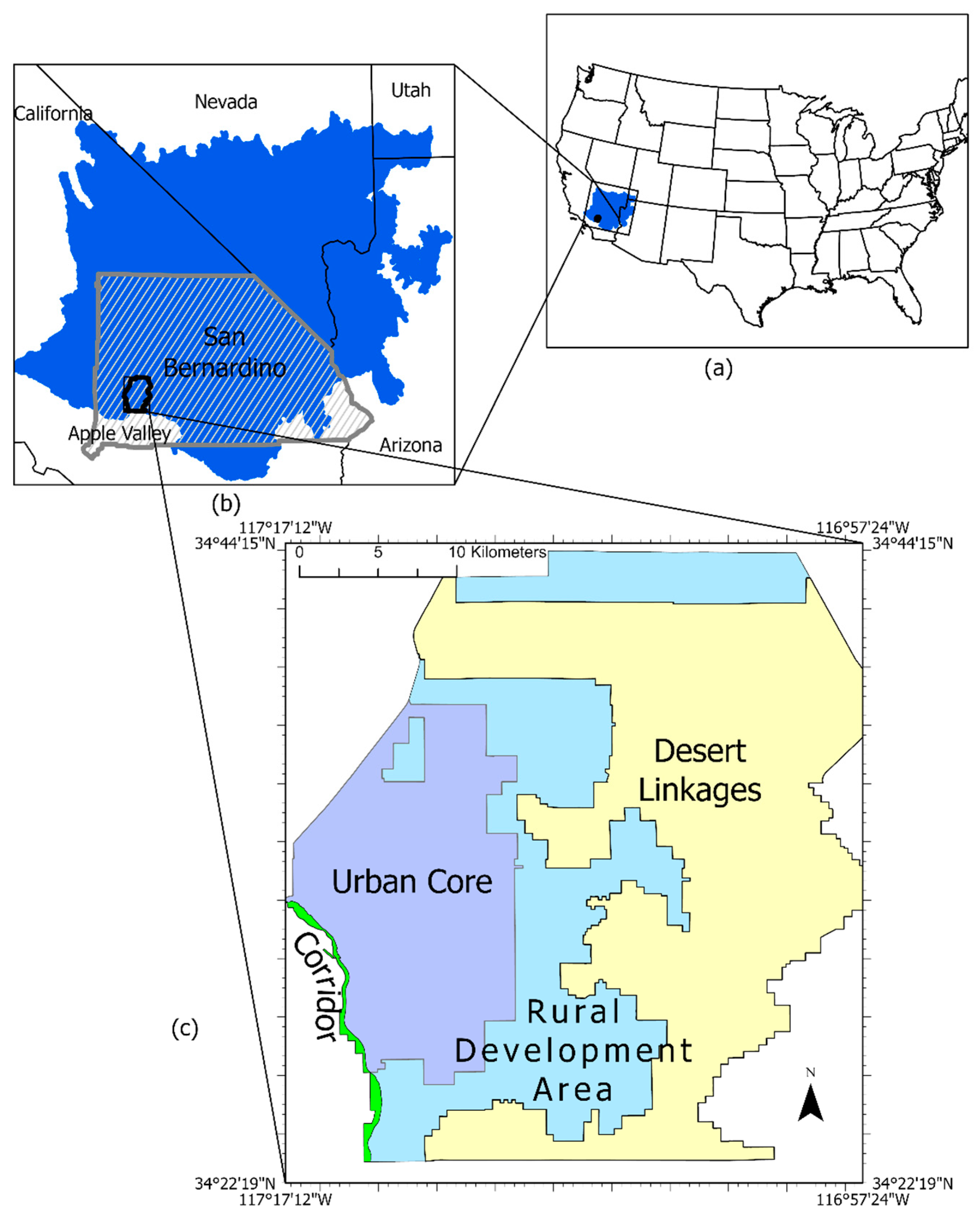
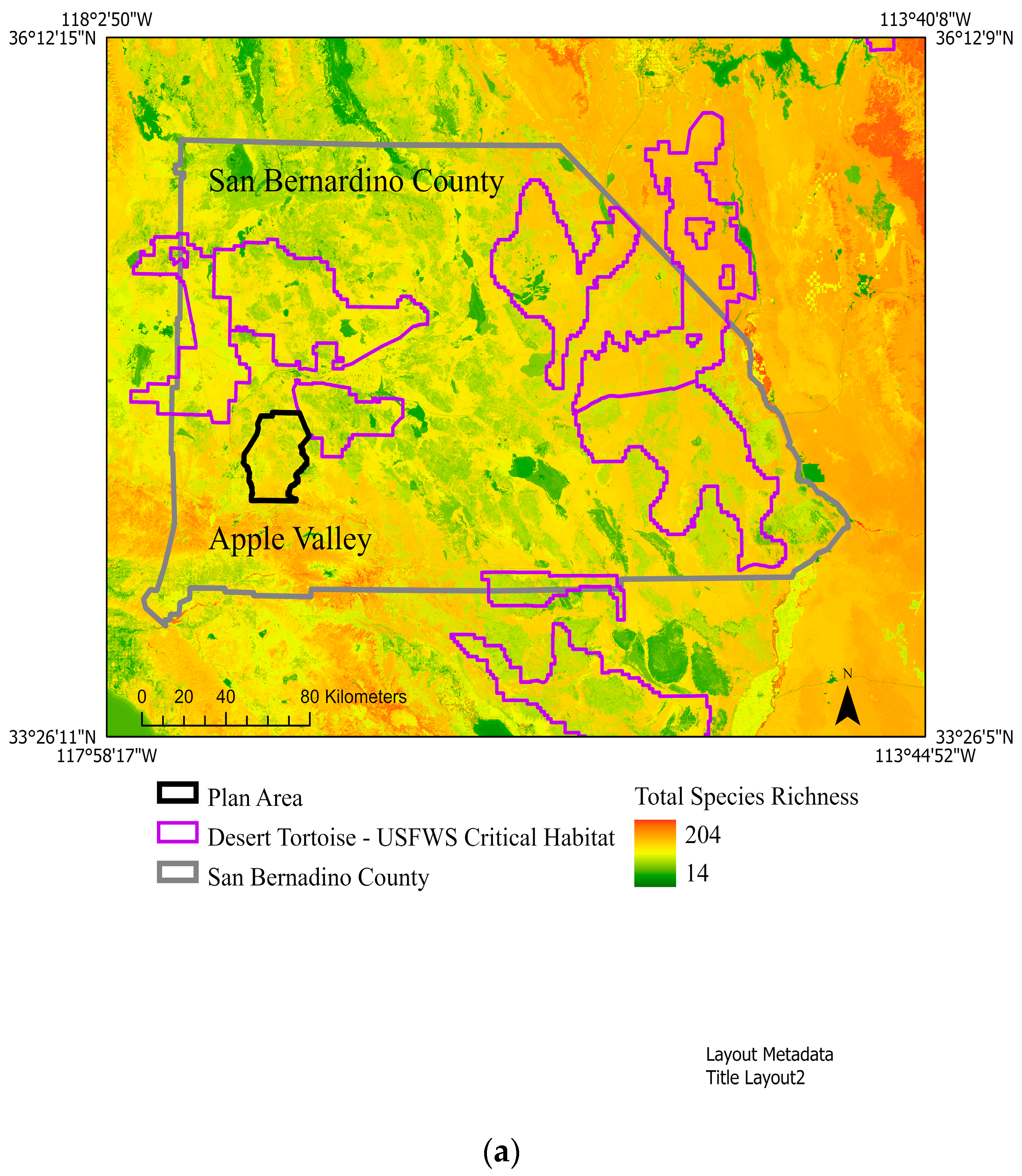
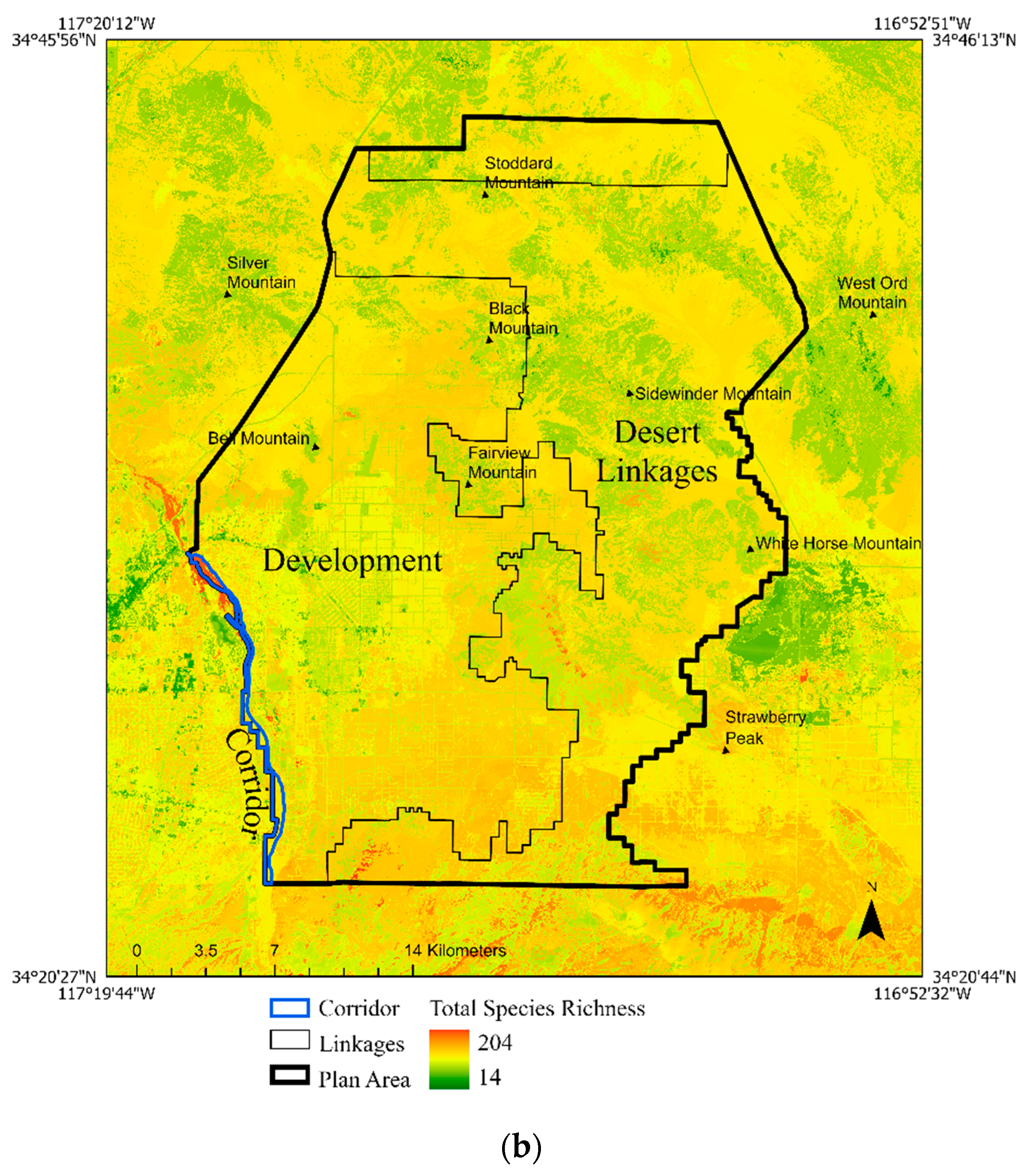
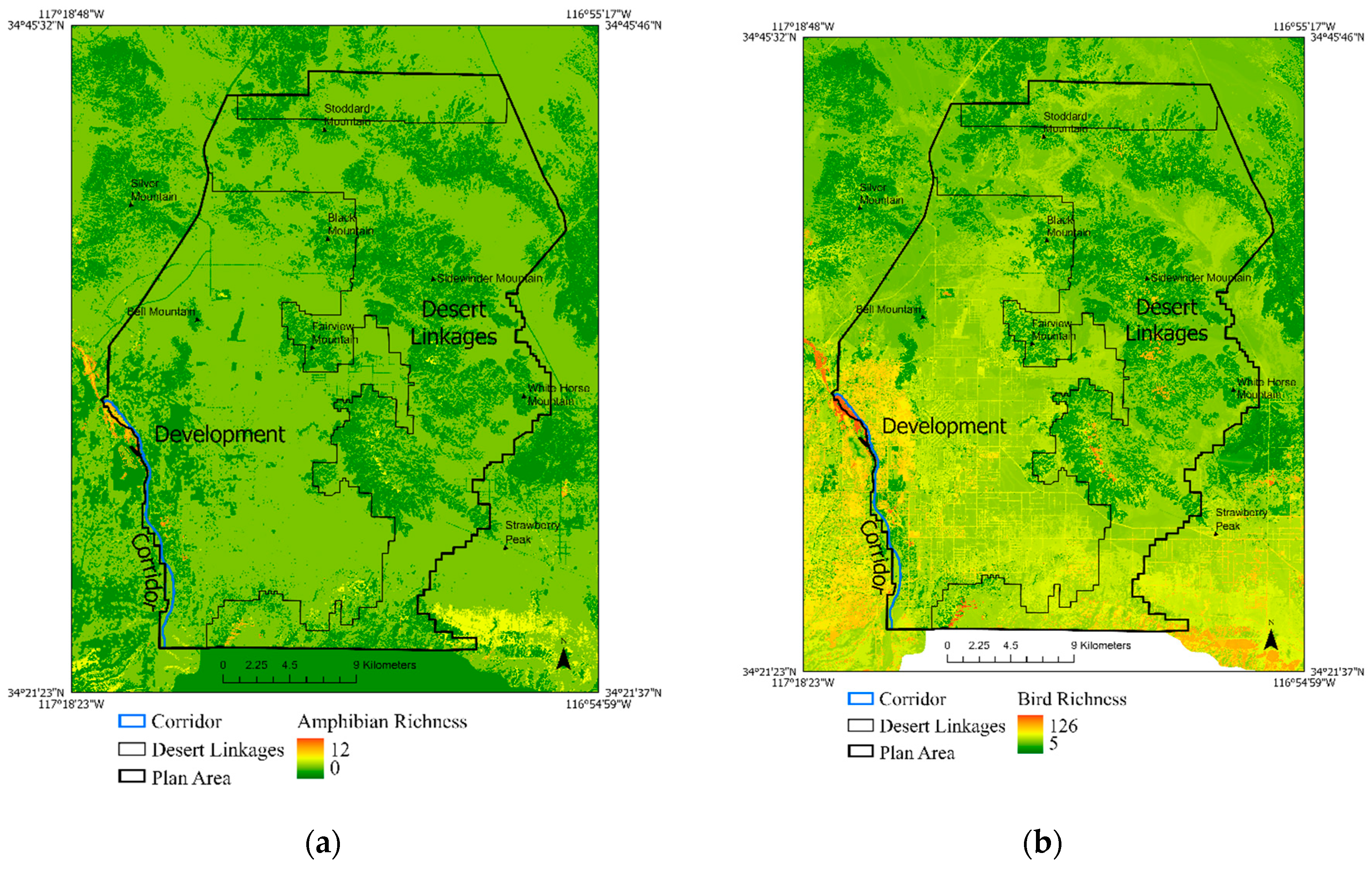

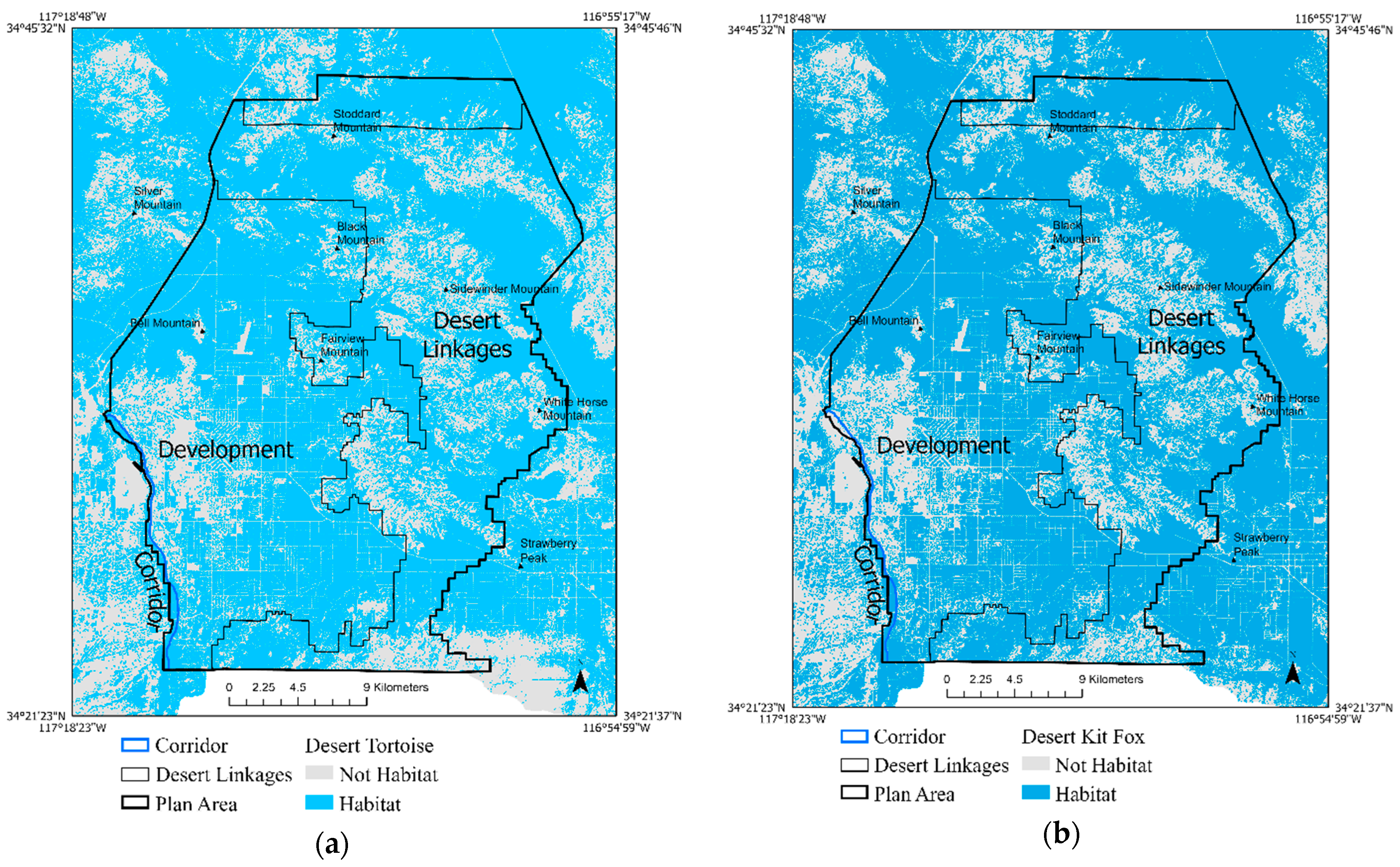

| Taxa | Common Name | Scientific Name | State Status | Federal Status | IUCN |
|---|---|---|---|---|---|
| Birds | Burrowing owl | Athene cunicularia | SSC 1 FGC 2 Sec. 3503.5 | BLM Sensitive and MBTA 4 | Least Concern |
| Golden eagle | Aquila chrysaetos | Fully Protected Watch List | Protected under BEGEP 3 Act and MBTA 4 BLM Sensitive | Least Concern | |
| Least Bell’s vireo | Vireo bellii pusillus | Endangered | Endangered and MBTA 4 | Least Concern | |
| Southwestern willow flycatcher | Empidonax traillii extimus | Endangered | Endangered and MBTA 4 | Least Concern | |
| Western yellow-billed cuckoo | Coccyzus americanus occidentalis | Endangered | Threatened BLM Sensitive and MBTA4 | Least Concern | |
| Mammals | Bighorn sheep | Ovis canadensis | Fully Protected | BLM Sensitive | Least Concern |
| Desert kit fox | Vulpes macrotis arsipus | Protected Furbearing Mammal | Least Concern | ||
| Reptiles | Agassiz’s desert tortoise | Gopherus agassizii | Threatened | Threatened | Vulnerable |
| Plants | Joshua tree | Yucca brevifolia | Under Status Review | Least Concern |
| Species Richness | ||||||
|---|---|---|---|---|---|---|
| Metric | Zone | Hectares | MEAN | MAX | Zone:MDE | NIB |
| Total Vertebrates | Development | 45,343 | 96.5 | 172 | 0.99 | 0.47 |
| Corridor | 560 | 109.7 | 173 | 1.12 | 0.54 | |
| Linkages | 44,101 | 91.2 | 175 | 0.93 | 0.45 | |
| MDE | 12,773,240 | 97.9 | 204 | 1.00 | 0.48 | |
| Amphibian | Development | 45,343 | 0.8 | 4 | 0.56 | 0.07 |
| Corridor | 560 | 1.3 | 4 | 0.83 | 0.11 | |
| Linkages | 44,101 | 0.7 | 4 | 0.43 | 0.05 | |
| MDE | 12,773,240 | 1.5 | 12 | 1.00 | 0.13 | |
| Bird | Development | 45,343 | 40.1 | 93 | 1.00 | 0.32 |
| Corridor | 560 | 50.5 | 94 | 1.26 | 0.40 | |
| Linkages | 44,101 | 34.5 | 95 | 0.86 | 0.27 | |
| MDE | 12,773,240 | 40.2 | 126 | 1.00 | 0.32 | |
| Mammal | Development | 45,343 | 29.9 | 46 | 0.96 | 0.53 |
| Corridor | 560 | 30.8 | 40 | 0.99 | 0.55 | |
| Linkages | 44,101 | 30.3 | 46 | 0.98 | 0.54 | |
| MDE | 12,773,240 | 31.0 | 56 | 1.00 | 0.55 | |
| Reptile | Development | 45,343 | 25.6 | 36 | 1.02 | 0.58 |
| Corridor | 560 | 27.1 | 36 | 1.08 | 0.62 | |
| Linkages | 44,101 | 25.7 | 36 | 1.02 | 0.59 | |
| MDE | 12,773,240 | 25.1 | 44 | 1.00 | 0.57 | |
| Mojave Desert Ecoregion | Plan Area | ||||||||
|---|---|---|---|---|---|---|---|---|---|
| Metric | Species | Modeled Habitat | MEAN | MAX | Zone: MDE | NIB | MEAN | MAX | NIB |
| Total Vertebrates | Desert Tortoise | No | 80 | 200 | 0.82 | 0.39 | 70.4 | 150 | 0.40 |
| Yes | 107 | 204 | 1.09 | 0.52 | 104.8 | 175 | 0.60 | ||
| Desert Kit Fox | No | 69.2 | 204 | 0.71 | 0.34 | 70.3 | 175 | 0.40 | |
| Yes | 108.9 | 187 | 1.11 | 0.53 | 104.6 | 150 | 0.60 | ||
| Amphibian | Desert Tortoise | No | 0.7 | 12 | 0.46 | 0.06 | 0.2 | 3 | 0.05 |
| Yes | 1.9 | 10 | 1.28 | 0.16 | 1.0 | 4 | 0.25 | ||
| Desert Kit Fox | No | 0.4 | 12 | 0.27 | 0.03 | 0.2 | 4 | 0.05 | |
| Yes | 2 | 8 | 1.28 | 0.16 | 1.0 | 3 | 0.25 | ||
| Bird | Desert Tortoise | No | 34.5 | 123 | 0.86 | 0.27 | 32.4 | 79 | 0.34 |
| Yes | 43.2 | 126 | 1.07 | 0.34 | 39.7 | 95 | 0.42 | ||
| Desert Kit Fox | No | 28.9 | 126 | 0.72 | 0.23 | 32.6 | 95 | 0.34 | |
| Yes | 44.6 | 111 | 1.11 | 0.35 | 39.6 | 77 | 0.42 | ||
| Mammal | Desert Tortoise | No | 27.1 | 56 | 0.87 | 0.48 | 22.1 | 46 | 0.48 |
| Yes | 33 | 49 | 1.07 | 0.59 | 33.8 | 44 | 0.73 | ||
| Desert Kit Fox | No | 23.4 | 56 | 0.76 | 0.42 | 21.8 | 44 | 0.48 | |
| Yes | 33.9 | 55 | 1.09 | 0.61 | 33.8 | 46 | 0.74 | ||
| Reptile | Desert Tortoise | No | 17.8 | 38 | 0.71 | 0.4 | 15.7 | 30 | 0.44 |
| Yes | 28.9 | 44 | 1.15 | 0.66 | 30.3 | 36 | 0.84 | ||
| Desert Kit Fox | No | 16.4 | 39 | 0.65 | 0.37 | 15.7 | 36 | 0.44 | |
| Yes | 28.5 | 44 | 1.13 | 0.65 | 30.2 | 36 | 0.84 | ||
Publisher’s Note: MDPI stays neutral with regard to jurisdictional claims in published maps and institutional affiliations. |
© 2021 by the authors. Licensee MDPI, Basel, Switzerland. This article is an open access article distributed under the terms and conditions of the Creative Commons Attribution (CC BY) license (https://creativecommons.org/licenses/by/4.0/).
Share and Cite
Boykin, K.G.; Kepner, W.G.; McKerrow, A.J. Applying Biodiversity Metrics as Surrogates to a Habitat Conservation Plan. Environments 2021, 8, 69. https://doi.org/10.3390/environments8080069
Boykin KG, Kepner WG, McKerrow AJ. Applying Biodiversity Metrics as Surrogates to a Habitat Conservation Plan. Environments. 2021; 8(8):69. https://doi.org/10.3390/environments8080069
Chicago/Turabian StyleBoykin, Kenneth G., William G. Kepner, and Alexa J. McKerrow. 2021. "Applying Biodiversity Metrics as Surrogates to a Habitat Conservation Plan" Environments 8, no. 8: 69. https://doi.org/10.3390/environments8080069
APA StyleBoykin, K. G., Kepner, W. G., & McKerrow, A. J. (2021). Applying Biodiversity Metrics as Surrogates to a Habitat Conservation Plan. Environments, 8(8), 69. https://doi.org/10.3390/environments8080069






